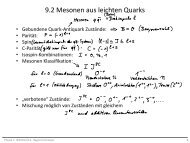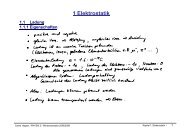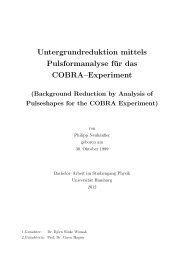Setup of a Drift Tube Muon Tracker and Calibration of Muon ...
Setup of a Drift Tube Muon Tracker and Calibration of Muon ...
Setup of a Drift Tube Muon Tracker and Calibration of Muon ...
You also want an ePaper? Increase the reach of your titles
YUMPU automatically turns print PDFs into web optimized ePapers that Google loves.
N [a.u.]Real DataReal data0.06MCh1Entries 182769Mean 3.433RMS 1.83N [a.u.]Real Data0.12Real DataMCh3Entries 182769Mean 0.3951RMS 0.1640.10.050.040.080.030.060.020.040.010.0200 1 2 3 4 5 6ϕ [rad]00 0.2 0.4 0.6 0.8 1 1.2 1.4θ [rad]Figure 3.14: Comparison <strong>of</strong> reconstructed <strong>and</strong> Monte Carlo (MC) cosmic data. Theleft figure shows the azimuth angular distribution. The two distinct peaks arise formthe non symmetrical setup <strong>of</strong> the trigger scintillators, the difference in their heightfrom a parallel shift. The right picture shows the polar distribution. The data isin good agreement with the simulation. However, small discrepancies remain, arisingfrom small uncertainties in the exact trigger positions <strong>and</strong> the fit.fulfill the following condition:r(θ) =θ∫dϑ sin ϑ cos 2 ϑ0π∫20dϑ sin ϑ cos 2 ϑ= 1 − cos 3 θ.Therefore θ is given byθ = cos −1 3√ 1 − r.Once all parameters have been generated, it is checked whether the resultingtrack would go through at least one scintillator layer above <strong>and</strong> below the detector.If this is the case, the event is considered triggered. Now the number <strong>of</strong> hit tubesis calculated. The event is saved to a tree with the same data structure as TData,extended by the simulated coordinates <strong>of</strong> the track.Fig. 3.14 shows a comparison <strong>of</strong> both the azimuth <strong>and</strong> zenith angular distributions<strong>of</strong> reconstructed real data with the Monte Carlo simulation. In general, thedata is in good agreement with the simulation. However, some small discrepanciescan be noted. In the azimuth distribution, two distinct peaks can be observed.They result mainly from the trigger scintillator setup. Whereas the scintillators werecrossed on top <strong>of</strong> the detector, they were placed parallel underneath, thus leavinga preferred direction for tracks along the y axis. This corresponds to values <strong>of</strong> ϕaround π <strong>and</strong> 3π 2. This alone still does not explain why one <strong>of</strong> the peaks is slightlylarger than the other. The relative heights <strong>of</strong> the peaks are very sensitive to theexact positions <strong>of</strong> the trigger scintillators. When the upper scintillators get shifted46





